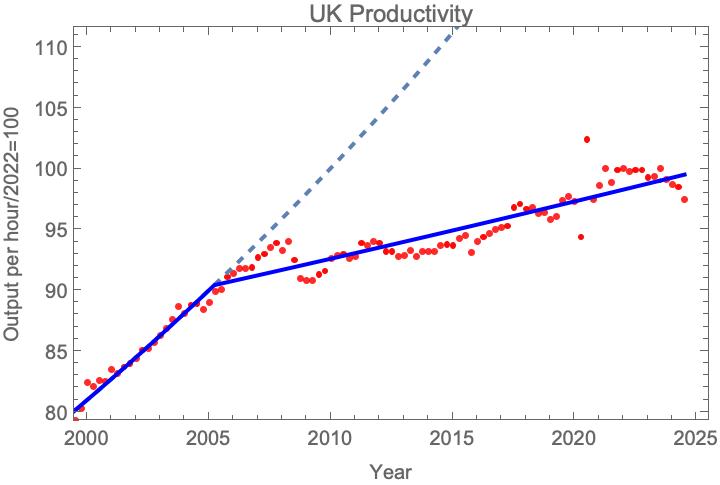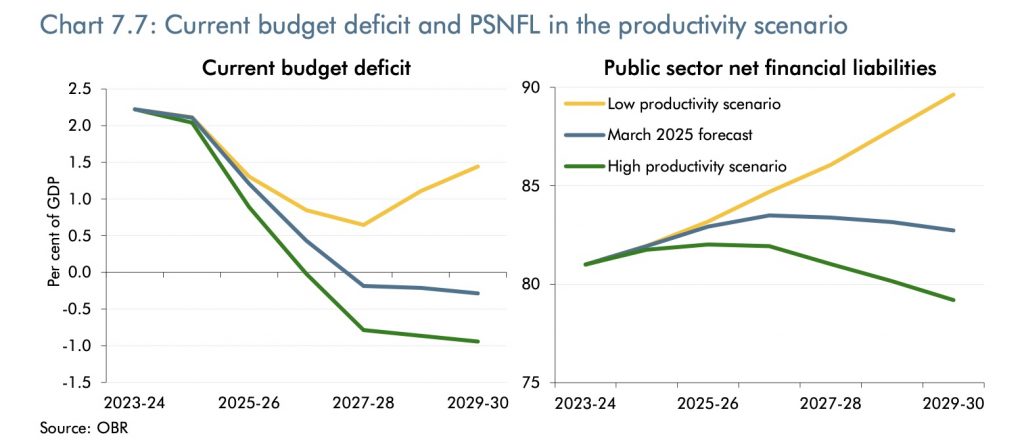Final Wednesday noticed the UK Authorities’s Spring Assertion on the financial system: basically a response to a brand new forecast from the Workplace of Budgetary Duty. This was politically painful – a deteriorating forecast signifies that the federal government must both scale back public spending or enhance taxes to ensure that the forecasts to satisfy its self-imposed constraints on public borrowing and the deficit. These forecasts are at all times unsure, and extremely depending on what assumptions are made concerning the future. This set of forecasts underline how necessary productiveness development – or the shortage of it – is for the power of the federal government to satisfy its commitments.
First, the place are we now? Right here is the newest productiveness knowledge. To recap, as I’ve been discussing for a while now, for a lot of the postwar interval, productiveness within the UK grew at a gentle price of two.1% a 12 months. That modified within the mid-2000s, within the run-up to the worldwide monetary disaster; the expansion price somewhat abruptly dropped to about 0.5% a 12 months. The cumulative impact is that the productiveness of the UK financial system is now some 28% under what it might have been if earlier pattern had continued.
UK Labour Productiveness index, quarterly knowledge. The strong blue line is a greatest match to a operate which assumes two durations of exponential development steady at a break level. See my submit When did the UK’s productiveness slowdown start? for particulars of the becoming methodology. One of the best match parameters are: pre-break development price: 2.1%, post-break development price: 0.48%, break at 12 months 2005.2. Information: ONS, Feb 18th 2025 launch.
Taking a extra close-up have a look at the final twenty years, one sees that there is no such thing as a signal of any restoration of productiveness development. Quite the opposite, the previous couple of quarters appear discouraging. I feel it’s in all probability too early to conclude that we’re transferring right into a interval of even decrease productiveness development – one wants to attend some time to see the long-term traits, and knowledge is usually revised. As well as in the mean time there’s a fear about high quality of the survey knowledge ONS makes use of to estimate complete hours labored, which provides additional uncertainty.

UK Labour Productiveness index, quarterly knowledge. Information: ONS, Feb 18th 2025 launch, match as within the plot above.
What’s the OBR predicting for the long run? It’s central forecast is predicated on the idea that productiveness development will increase by 2029 to a price which is kind of the typical of the pre-break and post-break values – 1.25%, with a rise of 0.2% to the expansion price attributed to planning reforms resulting in extra house-building. It has additionally modelled the impact of an upside situation, the place productiveness development of 1.2% is achieved in 2025, and a draw back situation persevering with current decrease pattern development of 0.3% a 12 months.

UK Labour Productiveness index, annual knowledge, along with the OBR’s March 2025 eventualities for productiveness development as much as 2029. Gray is the principle March forecast, yellow & inexperienced are excessive and low productiveness development eventualities.
The subsequent plot, from the OBR report, exhibits how a lot distinction assumptions about productiveness development make to the fiscal projections. With out the idea that productiveness development is about to extend considerably over the pattern it’s adopted for the final 15 years, the federal government’s fiscal targets for the debt and the deficit can’t be met. On this situation, the federal government would wish both to chop public spending additional or enhance taxes to satisfy these targets.

Impact of the totally different productiveness development eventualities on the OBRs fiscal forecasts. From the March 2025 Financial and Fiscal Outlook.
So, massive selections concerning the UK’s fiscal coverage are being made on the premise of predictions of future productiveness development, and the query of whether or not the federal government will meet its fiscal targets are very delicate to the assumptions being made. How a lot credence can we place on these forecasts? It does need to be pressured that the OBRs document on predicting productiveness development has been constantly overoptimistic since its institution, because the plot under exhibits. I feel this displays a wider failure by the UK’s financial and policy-making group to understand the size of the change to the UK financial system within the Nineties and 2000s and its long run results. There is no such thing as a extra necessary financial coverage query than to grasp the causes of the productiveness slowdown – and to seek out insurance policies to reverse this.

Successive OBR forecasts of productiveness and outturn. Supply: OBR


